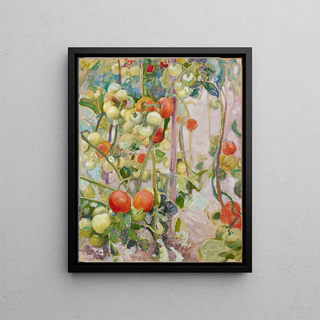Art print | Tomatoes - Pekka Halonen


View from behind

Frame (optional)
Tomato Art Print - Pekka Halonen – Captivating Introduction
In the vibrant universe of art, some works manage to capture the very essence of everyday life while transcending the mundane. "Tomato Art Print - Pekka Halonen" is a perfect example. This piece, which unfolds with apparent simplicity, invites us to immerse ourselves in a world where nature and art meet harmoniously. Through this vibrant depiction, Halonen succeeds in awakening our senses, sparking our curiosity, and allowing us to appreciate the beauty of everyday objects. Contemplating this work, one feels a deep connection with nature—a celebration of color and form that reminds us even the simplest elements can evoke profound emotional richness.
Style and uniqueness of the work
The uniqueness of "Tomato" lies in how Pekka Halonen manages to blend realism and impressionism. The tomatoes, presented with striking realism, seem almost tangible, as if one could touch them and appreciate their texture. The color palette chosen by the artist, oscillating between bright reds and lush greens, helps create a warm and inviting atmosphere. Each brushstroke appears imbued with intention, a search for the light that dances across the surfaces of the fruits. Halonen does not merely depict tomatoes; he captures a moment of life, an emotion, a story. The work, while rooted in reality, rises toward an almost poetic dimension, where each tomato becomes a symbol of vitality and beauty.
The artist and his influence
Pekka Halonen, an emblematic figure of Finnish art, knew how to leave his mark on his era with his unique approach and artistic vision. Born at the end of the 19th century, Halonen was influenced by Nordic landscapes and the particular light that bathes them. His style, imbued with deep sensitivity, evolved over the years, incorporating elements of naturalism while opening up to more modern inspirations. As an artist, he always sought to establish a dialogue between man and nature, and "Tomatoes" is a fine illustration of this. His work is not limited to simple representation; it evokes

Matte finish

View from behind

Frame (optional)
Tomato Art Print - Pekka Halonen – Captivating Introduction
In the vibrant universe of art, some works manage to capture the very essence of everyday life while transcending the mundane. "Tomato Art Print - Pekka Halonen" is a perfect example. This piece, which unfolds with apparent simplicity, invites us to immerse ourselves in a world where nature and art meet harmoniously. Through this vibrant depiction, Halonen succeeds in awakening our senses, sparking our curiosity, and allowing us to appreciate the beauty of everyday objects. Contemplating this work, one feels a deep connection with nature—a celebration of color and form that reminds us even the simplest elements can evoke profound emotional richness.
Style and uniqueness of the work
The uniqueness of "Tomato" lies in how Pekka Halonen manages to blend realism and impressionism. The tomatoes, presented with striking realism, seem almost tangible, as if one could touch them and appreciate their texture. The color palette chosen by the artist, oscillating between bright reds and lush greens, helps create a warm and inviting atmosphere. Each brushstroke appears imbued with intention, a search for the light that dances across the surfaces of the fruits. Halonen does not merely depict tomatoes; he captures a moment of life, an emotion, a story. The work, while rooted in reality, rises toward an almost poetic dimension, where each tomato becomes a symbol of vitality and beauty.
The artist and his influence
Pekka Halonen, an emblematic figure of Finnish art, knew how to leave his mark on his era with his unique approach and artistic vision. Born at the end of the 19th century, Halonen was influenced by Nordic landscapes and the particular light that bathes them. His style, imbued with deep sensitivity, evolved over the years, incorporating elements of naturalism while opening up to more modern inspirations. As an artist, he always sought to establish a dialogue between man and nature, and "Tomatoes" is a fine illustration of this. His work is not limited to simple representation; it evokes






